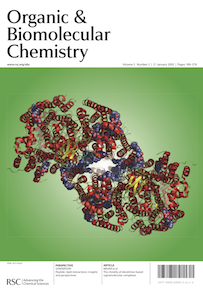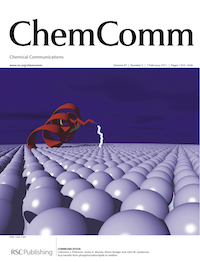
The Sanderson Group Webpages
Department of Chemistry
Durham University, Durham, UK
Membrane-Active Peptides


Work is being conducted on both designed model systems and known antimicrobial peptides, with the goals of understanding membrane activity and rigorously defining the chemical behaviour of peptides and proteins in membranes. Outcomes of this work include better methods for designing new membrane-active agents (e.g. as antimicrobials) and the detection of new processes that potentially occur in biological membranes.
Kinetics of Membrane Processes
Through a number of experiments,1–4 it has become clear that following the addition of a peptide to a membrane, equilibrium is achieved on a timescale of hours, and in some cases may not be achieved at all within a reasonable laboratory timescale. (more)
Intrinsic Lipidation
During the course of kinetics experiments, it became apparent that the chemical identity of the species present in the samples was continually changing.1,2 Through the use of liquid chromatography combined with tandem mass spectrometry, (MSn) we have identified acyl transfer from the lipid to the peptide as the cause of this change.1 This intrinsic lipidation reaction occurs without enzyme catalysis and will potentially occur with any membrane-embedded molecule. We have identified that amino groups (Lys, N-terminus) are particularly prone to lipidation. (more)
Designed Peptides
Bioinformatics excercises on prokaryotic β-barrel membrane proteins5 enabled us to define key structural features essential for the formation of stable transmembrane structures. On the basis of these exercises, we designed a number of cyclic peptides that porate liposomal membranes. Studying the kinetics of association of these peptides with membranes has revealed that binding is a two stage process. The first stage is rapid (seconds) and concomitant with membrane poration. The second stage is much slower, requiring hours for completion.4 (more)
References
- "The Association of Defensin HNP-2 with Negatively Charged Membranes: A Combined Fluorescence and Linear Dichroism Study", Catherine J. Pridmore, Alison Rodger and John M. Sanderson, Biochim. Biophys. Acta - Biomembr., 2016, 1858, 892–903.
- "The Innate Reactivity of a Membrane Associated Peptide Towards Lipids: Acyl Transfer to Melittin Without Enzyme Catalysis", Robert H. Dods, Jackie A. Mosely and John M. Sanderson, Org. Biomol. Chem., 2012, 10, 5371–5378.
- "Acyl Transfer from Phosphocholine Lipids to Melittin", Catherine J. Pridmore, Jackie A. Mosely, Alison Rodger and John M. Sanderson, Chem. Commun., 2011, 47, 1422–1424.
- "The Synergistic Action of Melittin and Phospholipase A2 with Lipid Membranes: Development of Linear Dichroism for Membrane-Insertion Kinetics", Angeliki Damianoglou, Alison Rodger, Catherine J. Pridmore, Timothy R. Dafforn, Jackie A. Mosely, John M. Sanderson and Matthew R. Hicks, Protein Pept. Lett., 2010, 17, 1351–1362.
- "Peptide Adsorption to Lipid Bilayers: Slow Processes Revealed by Linear Dichroism Spectroscopy", Sue M. Ennaceur, Matthew R. Hicks, Catherine J. Pridmore, Tim R. Dafforn, Alison Rodger and John M. Sanderson, Biophys. J., 2009, 96, 1399–1407.
- "The Design, Synthesis and Characterisation of Channel-Forming Peptides", John M. Sanderson and Sarah Yazdani, Chem. Commun., 2002, 1154–1155.